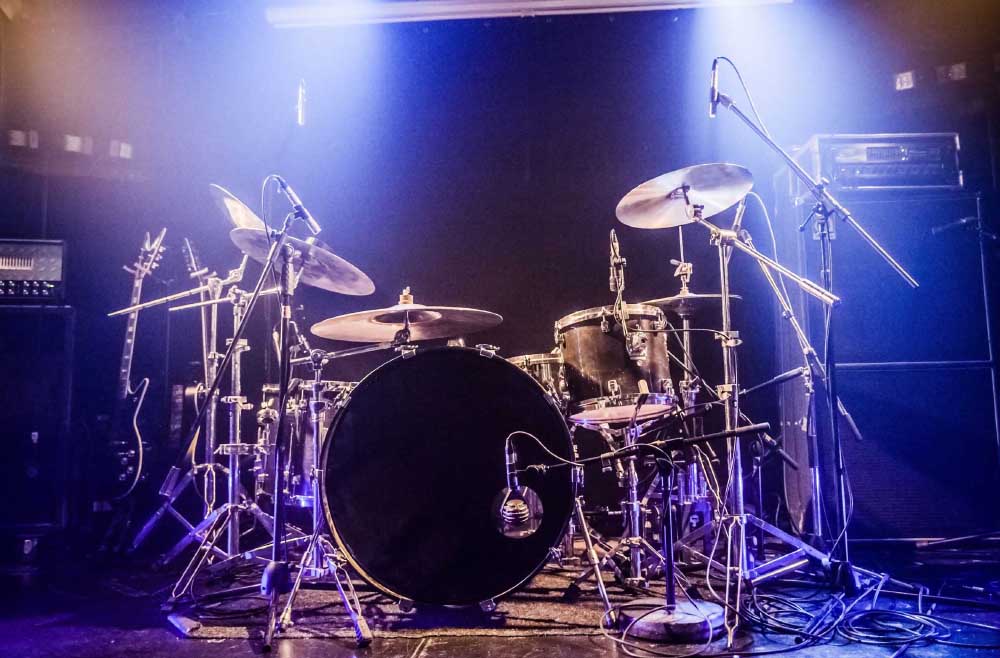I look at understanding proper equalization of live instruments as being one of the most important tools in our mental toolkit. And while equalizing a single instrument such as a keyboard or electric guitar can be pretty straightforward, drums offer a special challenge. That’s because a drum kit is really a bunch of separate instruments, each with its own microphone(s), processing, and so on.
Others may go into more detail about timbral equalization of mics for the basic sound of each drum, and certainly mic selection is a hot (and important) topic for drums, but I’m going to discuss what I’ve found over the years to be one of the least understood yet most important aspects of optimizing live drums. I call it frequency bracketing, and it’s very easy to do once you understand the concept.
Let’s begin by comparing the spectrum (frequency bandwidth) of two different drums in a standard kit: kick and snare. Most of the desirable energy of the kick drum exists in the bottom octave of a sound system, say 40 to 100 Hz or so.
And while we may like to make the sound of the kick “slap” a little at 5 kHz (or so), there’s really not a lot of useful sound energy in the top octave from 8 kHz to 16 kHz.
This is why we typically choose a large diaphragm mic for kick. We want to capture the “boom” and don’t care about the “tizz.” Listen to a kick drum playing solo and that’s pretty much what we hear. But have a drummer play the snare by itself while listening to the kick mic on headphones and we hear a lot more high frequencies than expected. This can contribute to two separate sonic problems: cross-triggering gates and transient smear/phase cancellation.
Gates & Triggers
First, I’ll address cross-triggering gates. Because the gate on the kick is monitoring the full bandwidth of the energy coming into it, the extra high-frequency energy of the snare leaking into the kick mic can make the gate double trigger. That is, if the gate is loosened up enough so that it can pick up a softer “hit,” then it can open up on the snare hit as well because it’s confusing the sound of the snare with the sound of the kick.
What’s an engineer to do? Modern digital consoles not only have a high-pass (or low-cut) filter, they also usually have a high-cut (or low-pass) filter as well. An important caveat before going any further: if we want to use EQ to control what the gate “hears,” the EQ must be placed before the gate in the signal chain, so the standard parametric channel EQ won’t work. Fortunately, on most digital consoles, the gate includes a “key filter” that is perfect for the job.
Getting back to the subject at hand, engage the high-cut filter and listen to the kick on its mic using headphones while sliding the high-cut frequency down into the 8 kHz range. Keep going down in frequency until you notice a loss of the top “edge” that’s usually wanted in a kick sound. If your console includes an RTA function on the input channels, you can actually watch the spectral energy reaching each mic, which will help in sliding the high-cut filter down to the proper frequency.
Next, have the drummer just hit the snare while listening to the kick mic and turning the channel EQ on and off. With the high-cut EQ engaged, you should hear a big drop in the snare energy leaking into the kick mic.
Then ask the drummer to play the entire kit while you solo only the kick mic in your headphones. As you turn the kick gate filter on and off you should hear a lot less “drums” and more “kick” with the high-cut filter in place. And now the gate trigger is more effective since it’s not being confused by all the extra high-frequency energy from the rest of the kit leaking into it.
A second benefit is a reduction of transient smear and phase cancellation when two separate mics hear the same sound at different distances. This can introduce several milliseconds of delay in the sound hitting the more distant mic that, when added to the closer mic, can cause phase cancellation.
Opposite Approach
Now let’s reverse the process and listen to snare mic in the headphones while having the drummer hit the kick. You’ll probably hear a lot more of the kick bottom than expected. And just as with the first example, this can lead to the gate on the snare being accidentally triggered by low-frequency energy of the kick drum.
Therefore, do the opposite trick of engaging the low-cut (high-pass) filter on the snare mic while hitting only the snare and watch how much bandwidth it really needs. Then slide the low-cut filter up to where it’s just touching the bottom of the snare frequencies, around 200 Hz or so, depending on snare size and tuning.
Have the drummer hit only the kick while soloing the snare mic in the headphones and you should hear a lot less “kick” in the snare mic. Again, this makes setting the snare gate easier since it’s not listening to the kick, and the kick transient impact will be cleaner since it’s not being picked up as much by the snare mic.
Now, that’s the easy part. The next step is to do this for every other mic on the kit. An obvious one is the overheads, which are primarily handling cymbals. I usually high-pass them anywhere from 200 to 400 Hz, depending on the kit.
Rack toms don’t have a lot of sonic energy below 100 Hz, so that’s where I set their high-pass filters. Floor toms are tuned a bit lower, so I usually set their high-pass filters around 60 to 80 Hz, varying again with shell size and tuning. Depending on how much “smack” you want from the toms, they can also be lowcut around 10 kHz or so without losing anything at all from the top end.
One other note: Because I personally don’t like a dark-sounding hi-hat, I usually set the high-pass frequency for it around 150 Hz.
What we’ve now accomplished is setting a bunch of spectrum brackets around each drum input that limits what that they hear to what each drum is actually putting out. These sonic “gobos” go a long way to cleaning up the sound of the entire kit since there’s much less low-frequency leakage into the high mics and vice versa.
By using a combination of the built-in channel RTA on a digital console and most importantly, our ears, it’s easy to create sonic brackets around not only the kit, but every other instrument on the stage.















